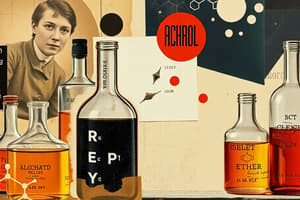Podcast
Questions and Answers
What is the general formula for alcohols?
What is the general formula for alcohols?
The general formula for alcohols is R-OH, where R is an alkyl group.
Why do alcohols have higher boiling points than alkanes?
Why do alcohols have higher boiling points than alkanes?
Alcohols have higher boiling points than alkanes due to hydrogen bonding.
What makes phenols more acidic than alcohols?
What makes phenols more acidic than alcohols?
Phenols are more acidic than alcohols due to resonance stabilization of the phenoxide ion.
How does the solubility of alcohols change with molecular weight?
How does the solubility of alcohols change with molecular weight?
Name one use of ethanol in the food and beverage industry.
Name one use of ethanol in the food and beverage industry.
How do alcohols and phenols differ in terms of reactivity?
How do alcohols and phenols differ in terms of reactivity?
What is a common use for isopropanol?
What is a common use for isopropanol?
List two applications of phenols in industry.
List two applications of phenols in industry.
What property allows alcohols to interact favorably with water?
What property allows alcohols to interact favorably with water?
Why are phenols considered important in dye manufacturing?
Why are phenols considered important in dye manufacturing?
Flashcards are hidden until you start studying
Study Notes
Properties of Alcohols
- General Formula: R-OH, where R is an alkyl group.
- Polarity: Alcohols are polar due to the hydroxyl (-OH) group, leading to hydrogen bonding.
- Boiling Points: Higher boiling points than alkanes due to hydrogen bonding.
- Solubility: Low molecular weight alcohols (C1 to C3) are soluble in water; solubility decreases with increasing molecular weight.
- Acidity: Alcohols are weak acids; they can donate protons (H+) in reactions.
- Reactivity: Act as nucleophiles in substitution and elimination reactions.
Properties of Phenols
- Structure: Aromatic compounds containing a hydroxyl (-OH) group directly attached to a benzene ring.
- Polarity: More polar than alkanes due to the -OH group; can form hydrogen bonds.
- Boiling Points: Higher than alkanes and lower than alcohols due to resonance stabilization.
- Acidity: Phenols are more acidic than alcohols due to resonance stabilization of the phenoxide ion.
- Reactivity: Reacts with electrophiles and undergoes substitution reactions on the aromatic ring.
Uses of Alcohols
- Solvents: Commonly used in paints, inks, and varnishes.
- Antiseptics: Ethanol and isopropanol are widely used in hand sanitizers and disinfectants.
- Fuel: Ethanol is used as a renewable fuel source and additive in gasoline.
- Industrial: Used in the manufacture of plastics, cosmetics, and pharmaceuticals.
- Food and Beverages: Ethanol is the primary alcohol in alcoholic beverages.
Uses of Phenols
- Antiseptics: Used as disinfectants due to antimicrobial properties (e.g., phenol itself).
- Chemical Intermediates: Important in the production of plastics, resins, and pharmaceuticals.
- Antioxidants: Used in cosmetics and food preservation to prevent oxidation.
- Dyes and Pigments: Serve as precursors in dye manufacturing.
- Pesticides: Used in the formulation of phenolic pesticides.
Properties of Alcohols
- General formula is R-OH; R represents an alkyl group.
- Alcohols exhibit polarity from the hydroxyl (-OH) group, allowing for hydrogen bonding interactions.
- Boiling points are significantly higher than those of alkanes due to the presence of hydrogen bonds.
- Solubility in water is notable for low molecular weight alcohols (C1 to C3), with a decrease in solubility as molecular weight increases.
- Function as weak acids, capable of donating protons (H+) during chemical reactions.
- Serve as nucleophiles in both substitution and elimination reactions, impacting their reactivity.
Properties of Phenols
- Composed of an aromatic ring with a hydroxyl (-OH) group attached directly to it.
- More polar compared to alkanes, allowing for hydrogen bond formation due to the -OH group.
- Boiling points are higher than alkanes, yet lower than alcohols due to resonance stabilization effects.
- Exhibits greater acidity than alcohols, attributed to the resonance stabilization of the phenoxide ion formed upon deprotonation.
- Reacts readily with electrophiles and participates in substitution reactions on the aromatic ring.
Uses of Alcohols
- Widely utilized as solvents in products like paints, inks, and varnishes.
- Ethanol and isopropanol serve as active ingredients in hand sanitizers and disinfectants for their antiseptic properties.
- Ethanol is a renewable fuel source and is commonly used as an additive in gasoline formulations.
- Integral in the production of various industrial products including plastics, cosmetics, and pharmaceuticals.
- Ethanol is the main type of alcohol found in alcoholic beverages.
Uses of Phenols
- Phenol and its derivatives are used as disinfectants owing to their antimicrobial properties.
- Serve as crucial chemical intermediates in the manufacture of plastics, resins, and drugs.
- Employed as antioxidants in cosmetics and food products to combat oxidation and spoilage.
- Play a significant role in dye manufacturing as precursors for various dyes and pigments.
- Utilized in the creation of phenolic pesticides, contributing to agricultural pest management.
Studying That Suits You
Use AI to generate personalized quizzes and flashcards to suit your learning preferences.




